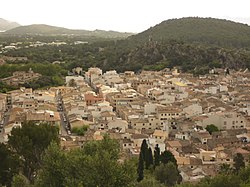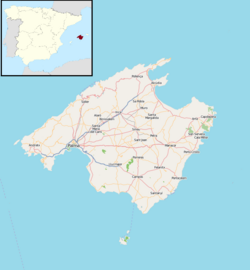Pollença
Pollença
| |
|---|---|
 | |
 Flag  Coat of arms | |
 Location of Pollença in Mallorca | |
 Pollença Location in Majorca | |
| Coordinates: 39°52′38″N 3°0′59″E / 39.87722°N 3.01639°E | |
| Country | Spain |
| Autonomous community | Balearic Islands |
| Province | Balearic Islands |
| Comarca | Sierra de Tramontana |
| Judicial district | Inca |
| Government | |
| • Mayor | Miquel Àngel March (Junts Avançam; 2015) |
| Area | |
| • Total | 151.65 km2 (58.55 sq mi) |
| Elevation | 47 m (154 ft) |
| Population (2018)[1] | |
| • Total | 16,189 |
| • Density | 110/km2 (280/sq mi) |
| Time zone | UTC+1 (CET) |
| • Summer (DST) | UTC+2 (CEST) |
| Postal code | 07460 |

Pollença (Balearic Catalan: [poˈʎɛnsə]; Spanish: Pollensa) is a town and municipality situated in the northern part of the island of Majorca, near Cap de Formentor and Alcúdia. It lies inland, about 6 km (4 mi) west of its port, Port de Pollença.
History[]
This section needs expansion. You can help by . (May 2010) |
The name "Pollença" comes from the name of the Roman settlement of "Pollentia," the excavated remains of which lie several kilometers away, at the modern municipality of Alcúdia. It was founded by the Catalans[citation needed] in the 13th century some 6 km (4 mi) from the coast in an effort to avoid pirate attacks.
Main sights[]
Most houses were built in the 17th and 18th centuries and many streets are very narrow and compact, a legacy from the medieval era. The central square, called Plaça Major, has numerous outdoor cafés and is dominated by a large 13th-century church Esglèsia de Nostra Senyora dels Àngels (Our Lady of the Angels) which was built by the Knights Templar.
One of the town's most distinctive features is the 365-step stairway north of the square; this leads up to a chapel on top of the hill known as Calvary. On Good Friday this is the setting for the most dramatic parade of the year. First, on the road winding up the back of the hill, there is a reenactment of the Stations of the Cross. This is followed by a mock crucifixion on top of the hill after which the figure of Christ is ceremonially removed from the Cross. There is a sombre, torchlit parading of the body of Christ through the town led by hundreds of people in cloaks, masks and pointed hats and done in total silence save for the slow beating of a drum.
The town also has a 19th-century bridge of Romanesque design that crosses a stream to the north of town.
Most visited sights in Pollença town: Plaça Mayor, Plaça Vella, Can Llobera, Convent, Joan March Gardens, Calvari and Roman Bridge.
Beaches[]
- Cala Figuera
- Cala Murta
- Cala Formentor
- Cala Sant Vicenç (Cala Molins, Cala Barques, Cala Clara and Cala Carbó)
- Cala Boquer
- Puerto Pollença Beach
- Llenaire Beach
- Can Cuarassa Beach

Cala Figuera.

View from the top of the 365 Calvari Steps

At the top of the 365 Calvari Steps is this church
References[]
- ^ Municipal Register of Spain 2018. National Statistics Institute.
External links[]
| Wikimedia Commons has media related to Pollença. |
 Pollença travel guide from Wikivoyage
Pollença travel guide from Wikivoyage- Pollença tourist guide
- SOM POLLENÇA, tourist municipality
- The Roman City of Pollentia
- Pollensa Town
- Pollença
- Populated places in Mallorca





